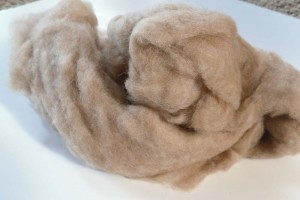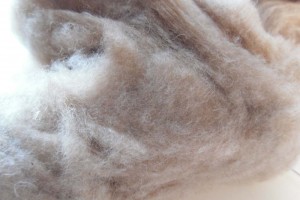I picked up some camel fiber and fell in love with the first touch. I had to find out more.
Picture courtesy of Michael Pereckas
Camel hair is, variously, the hair of a camel; a type of cloth made from camel hair; or a substitute for authentic camel hair; and is classified as a specialty hair fibre. When woven into haircloth, using the outer protective fur called guard hair, camel hair is coarse and inflexible. However, other varieties of camel hair cloth—especially those that blend camel hair with wool— or from the pure under coat are soft and plush. Pure camel hair, frequently used for coats, is gathered when camels molt in warmer seasons. This undercoat is very soft, and is separated from the dense, coarse guard hair for cloth use(wikipedia).
So I guess what I have is the undercoat of the camel as it is deliciously soft.
Camel hair is collected from the two-humped Bactrian camel, found from Turkey east to China and north to Siberia. Significant supplier countries of camel hair are: Mongolia, Iran, Afghanistan, Russia, China, and Australia.

- John Hill took this photo on a trip along the Southern Silk Road between Yarkand and Khotan.
A camel can produce around 5 pounds of hair a year. The specialty animal fibre is collected by a number of methods including combing, shearing, and collecting the hair shed naturally during the moulting season. During the moulting season the hair falls off first from the neck, then the mane and lastly the body hair. The moulting season occurs in late spring and is a process that takes six to eight weeks.
The color of camel is primarily golden tan with a variance of red to light brown tones. Camel’s hair is also a fibre that supplies warmth without added weight. The hair contains thermostatic properties which can protect and insulate the camel from the extreme cold conditions as well as keeping them cool in the desert. The same properties and characteristics are transferred when making fabrics woven from camel hair.
Just a note I saw on wikipedia said that in 2002 wild bactrian camels were critically endangered ( one step before extinct in the wild). I went and found the recent assessment here. It seems even at 2011 this animal is still critically endangered. Camels only give birth every 2 yrs. So increaseing the numbers is slow, predation by people and wolves has been decreasing their numbers.
The ‘Great Gobi Reserve A’ was established in Mongolia in 1982 and in 2000, the ‘Arjin Shan Lop Nur Nature Reserve’ was established in China. Although the first phase of Nature Reserve construction is now complete, much more work, including the opening of a second Nature Reserve in China is needed(ICUN Red List).
The establishment of a captive Wild Bactrian Camel breeding programme in Mongolia has been established by the Wild Camel Protection Foundation. This is an urgent conservation priority. Only fifteen wild Bactrian camels are currently in captivity in China and Mongolia. With so few captive animals, the whole species could be wiped out if their natural habitats in China and Mongolia are destroyed. It is therefore important to breed enough animals in captivity to insure against this possible disaster(wikipedia).
Here is my camel fiber.












another favourite!!
I love camel fiber too.